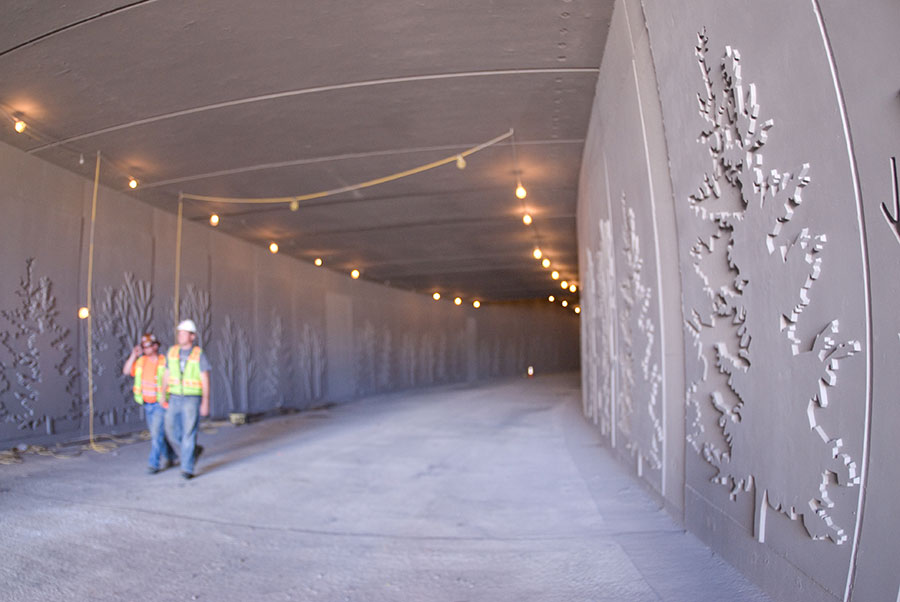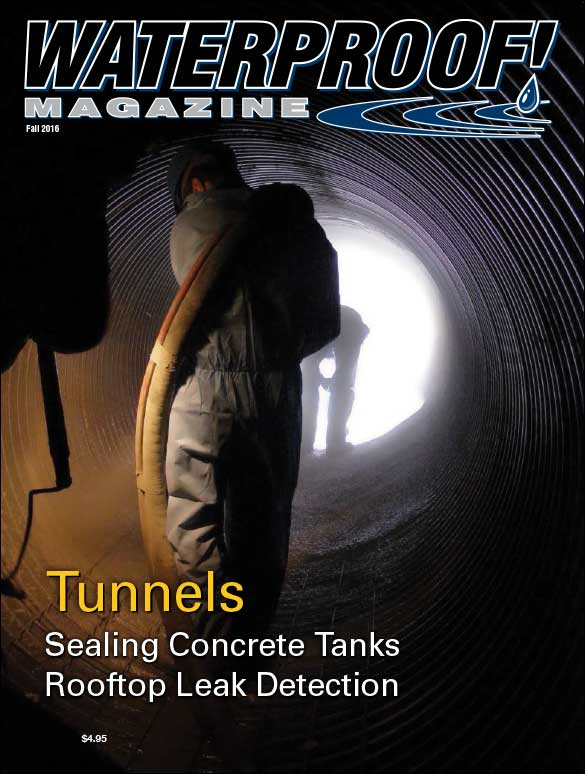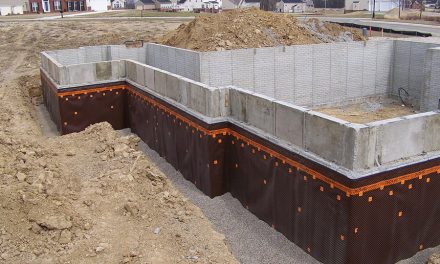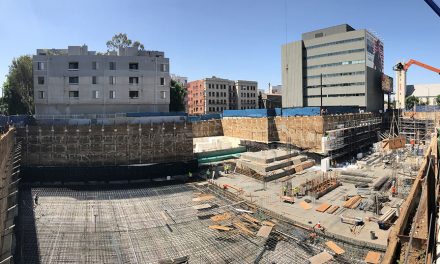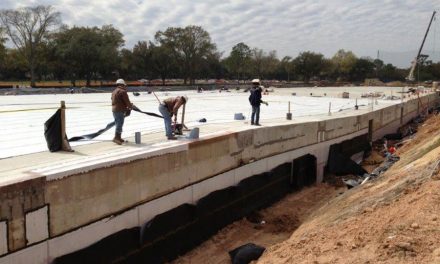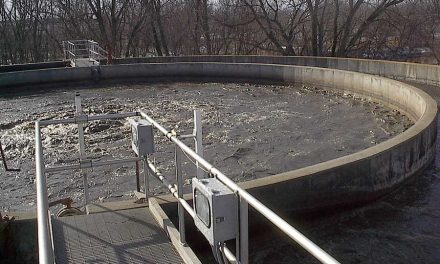The Bremerton Tunnel was waterproofed using a crystalline admix, which is self-sealing and less expensive than the alternative. Form liners were used in the 17 cast-in-place tunnel segments to create patterns on the walls.
Construction Methods
The vast majority of below-grade “tunneling” projects today are actually created using cut-and-cover construction methods. This method—excavated from the surface, then re-covered—is usually cheaper and more practical than bored tunneling. It’s especially practical at shallow depths (30 to 40 feet) but depths to 60 feet are not uncommon. It’s the overwhelming method of choice for traffic, rail and pedestrian underpasses, utility tunnels, and a host of other applications.

The Boston CSO project used pre-cast sections set into place using cut-and-cover techniques.
Small utility tunnels are typically assembled from precast segments. Larger tunnels use cast-in-place concrete, shotcrete, or a combination such as a precast tunnel roof placed onto cast-in-place walls. Waterproofing solution vary based on how the project is built, the construction timetable, and jobsite conditions.
Spray-on membranes are common in shallow tunnels, but become rarer as the depth increases. In bored tunnels, sheet goods are typically specified, and the drainage layer omitted.
Perhaps the biggest determinant in selecting a waterproofing system is whether the waterproofer has access to install the membrane from the exterior. Otherwise, blindside construction techniques are used.

Waterproofing for the Gateway Connector Highway in West Virginia needed to withstand acidic groundwater generated from nearby coal mines.
In recent years crystalline waterproofing has surged in popularity. It has been used in a wide range of tunnel projects with great success.
Pre-Cast
Several years ago, the city of Boston embarked on a $150 million project to reduce harbor pollution by capturing stormwater runoff. Called the combined sewer overflow system (CSO), the main component is a tunnel, 17 feet in diameter and running 2.5 miles (4.0 km) under the shoreline, that captures the runoff from all the stormwater drains in South Boston and essentially serves as a giant holding tank, allowing the existing wastewater treatment plants to process the excess in the days and weeks after the storm.
The main tunnel was bored, but all the connections to the existing storm drains used pre-cast concrete box culverts buried as much as 20 feet into the ground. Most of them (2,810 lineal feet) measured 12’x12’, with 760 combined lineal feet of 9’ x 8’ and 8’ x 8’ culverts.
These culverts were sealed with a crystalline waterproofing compound from Xypex, rather than using a membrane system.

The 500-foot-long Bremerton Tunnel used soldier piles, lagging and shotcrete to secure the sides of the excavation.
According to Les Faure, marketing manager at Xypex, the system was recommended by the manufacturer of the pre-cast culvert boxes. Added to the concrete at the time of batching, Xypex Admix C-500 forms a non-soluble crystalline structure throughout the concrete, waterproofing and protecting it from the moment it’s poured.
In previous CSO projects, Boston Water and Sewer relied on a coal-tar-and-epoxy product which required significant ventilation and drying time, and also created environmental and liability issues. The crystalline admix is non-toxic to begin with and produces no waste in the manufacturing process. Once added to the mix, the concrete is protected against deterioration from the harsh chemical contents of the sewer environment.
John Bauld, senior project manager with D’Allessandro Construction, who played a major role with this project, says, “This innovative process saved us considerable manufacturing time and virtually eliminated any environmental impact common in the preparation process – and it’s more cost effective. We cut the time of manufacturing-to-shipping from 30 days to less than 10.”
The culvert portion of the work was completed in 2009, and the entire CSO project became operational in June 2011.
Cast-in-Place
On the West Coast, crystalline waterproofing was used on the cast-in-place, cut-and-cover Bremerton Tunnel, across Puget Sound from Seattle, Wash. Brenden Clarke, project engineer for Washington State Dept. of Transportation (WSDOT), described the tunnel as a self-supporting concrete box structure with 17 concrete segments, each measuring two lanes wide, 55 feet long and 16½ feet high.
Excavation began in the summer of 2007 and—even though extensive soil testing had been done—soon revealed several surprises, including underground tanks, asbestos, and a buried garbage dump containing two Model-T Fords. “We found not just petroleum (contamination) but also metals and PCBs,” Clarke said.
The primary excavation was a 500-foot-long trench 30 feet deep. Material was removed in five-foot lifts and the walls secured with shotcrete and soil nails as the work progressed. In deeper areas, beams and tiebacks were also used.
The concrete box structures that make up the tunnel are poured in place. “Waterproofing the tunnel was a difficult challenge,” Clarke says. The contractor, Tri-State, recommended crystalline waterproofing from Xypex, which was not only self-sealing but was also less expensive than the alternative.

Crystalline waterproofing was also used to seal miles and miles of subway lines in São Paulo, Brazil, built using
cast-in place concrete and slip forms.
Tri-State also recommended using concrete form liners to create relief patterns on the walls. They reused form liners from a previous project to hold down costs. Some of the walls have a tree silhouette pattern, while others mimic the look of basalt. The tunnel was completed in 2009 at a cost of $1.6 million.
Penetron was also used to waterproof more than a dozen kilometers of subway line in São Paulo, Brazil, built using the “cut and cover” technique of cast-in place concrete and slip forms. It was also used to seal the station walls, and all concrete joints.
Shotcrete
Shotcrete is frequently used in tunnel work to strengthen and stabilize the excavation. It also helps smooth the rough edges of exposed rock, piles, rock bolts and soil nails. Often, shotcrete is applied as the final tunnel lining.
Crystalline waterproofing has proven successful for this type of tunnel construction as well, such as on the Gateway Connector Highway in West Virginia. This 1.5-mile road connects Fairmont, WV, to the Interstate 79 highway.

Due to acidic mine drainage in the area, crystalline waterproofing was used on the Gateway Connector.
Fairmont has a rich history of coal mining, supplying the steel mills and factories of Pittsburgh and in the Ohio River Valley. But an overland route for the city was long neglected, depriving the area of a connection to the state’s “High Tech Corridor,” that hosts a large number of biometric and identity security firms.
The tunnel was in the design phases for more than 25 years. Construction finally began in 2002 and took more than a decade to complete. One reason for the delay was the discovery of pockets of aggressive groundwater conditions, including acidic mine drainage from nearby coal mines.
To address these concerns, the West Virginia Division of Highways asked Central Builder, the concrete supplier, to find an solution. Ultimately, the project design engineers specified a crystalline waterproofing admixture from Penetron. It was used to seal the stormwater collection facilities, interconnecting vaults, and in the critical tunnel lining.

Shotcrete enhanced with crystalline waterproofing was used to seal the stormwater collection tunnels as well as the vaults and tunnel lining.
“Essentially, it protects the concrete from the inside out through a crystalline lattice that permanently seals hairline cracks over the lifetime of the concrete,” explains Chris Chen, director of The Penetron Group. “The structure of the Gateway Connector is now fully protected from water penetration, freeze thaw damage, and aggressive waterborne contaminants.”
It’s worth noting that within the past decade, manufacturers have updated their guidelines, recommending that the product be added directly to the shotcrete during the batching process, rather than applied separately. “It’s more effective from both a performance and a cost basis,” says Chen.
Fall 2016 Back Issue
$4.95
Solutions for Tunnel Waterproofing
Real-Time Automated Leak Detection
Sealing Commercial Concrete
Project Profile: Voxman Music Building
AVAILABLE AS DIGITAL DOWNLOAD ONLY
Description
Description
Solutions for Tunnel Waterproofing
The massive scale and hydrostatic pressure of tunnel projects require special waterproofing solutions, especially when groundwater is contaminated.
Real-Time Automated Leak Detection
New technology is available to monitor roof membrane performance in real-time. This is especially useful in ballasted and green roof applications.
Sealing Commercial Concrete
When a concrete tank 45 feet below the water table began leaking, the solution was as innovative as it was effective.
Project Profile: Voxman Music Building
Rebuilding from a massive 2008 flood, the University of Iowa rebuilt their music building to withstand moisture above and below grade.
Additional Info
Additional information
| Magazine Format | Digital Download Magazine, Print Mailed Magazine |
|---|

